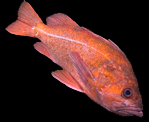
Kawika's Favorite Fifteen
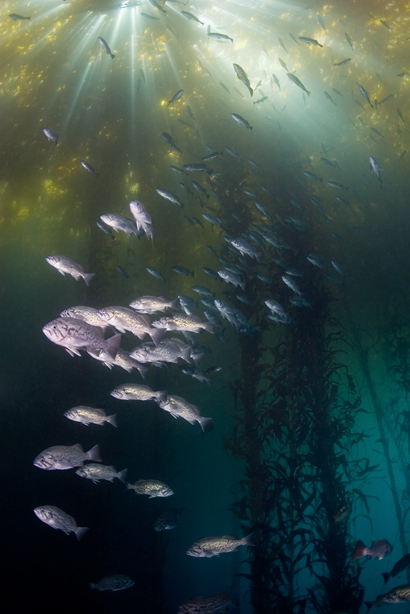
At depth, stands of giant kelp (Macrocystis sp.) are sparse. On the
water's surface, however, their lush canopy may permit only a few beams of
sunlight to pass. The surreal sensation of swimming just beneath the canopy as
these always dancing and occasionally blinding rays contrast with the shadows of
lurking blue rockfish (Sebastes mystinus) enchants almost all who
experience it. Environmental activist and long time dive boat captain Ed Cooper
was so taken with these lights that he named them "God beams". It's a fitting
appellation for one of many dive experiences that photograph poorly. This is
easily the closest I've come to capturing the feeling, but it lacks the sense of
immersion that comes with the real thing.
"Butterfly House", Carmel Bay, California
July 23, 2005
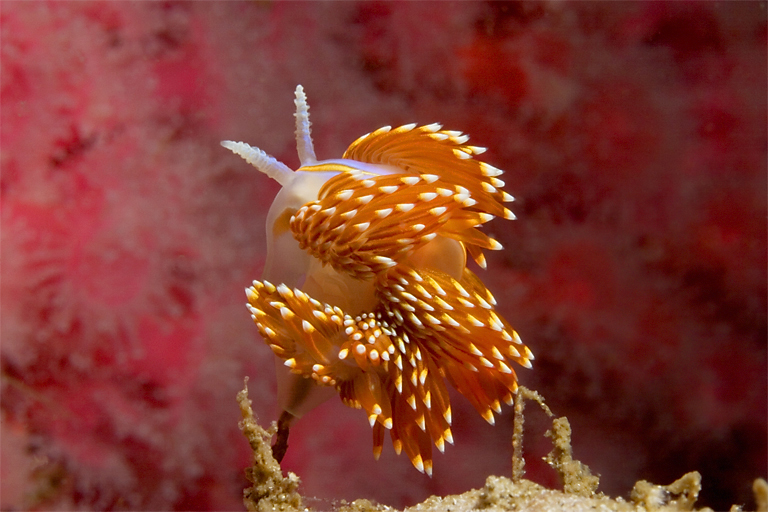
The cerata of this egg laying Hermissenda crassicornis are disheveled by
the water's surge, while its two annulate rinophores protrude upward. Visible in
the background is a colony of Corynactis californica that lines a cavity
in the tracks of a sunken World War II era amphibious landing tank. These
vehicles are commonly called "amtraks", a condensation of "amphibious tracked".
Hermissenda is one of many creatures in Monterey that, from time to time,
appear in large numbers. This specimen was one of perhaps several hundred that
had aggregated on one side of an amtrak.
"Mating Amtraks", Monterey Bay, California
July 9, 2005
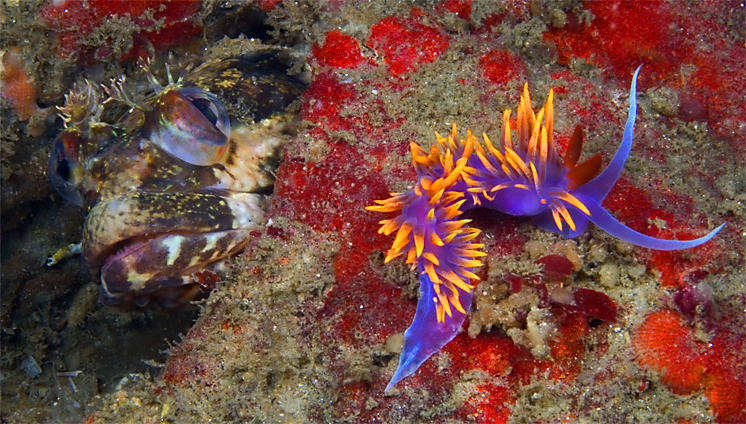
This spanish shawl (Flabellina iodinea) appears to be in danger of
becoming a colorful snack for a onespot fringehead (Neoclinus
uninotatus). Thankfully for the shawl, its wild coloration is indicative of
it's ability to sting potential predators. Spanish shawls rove the reef in
search of the hydroids upon which they feed. Interestingly enough, a shawl's
stinging ability comes from special cells called nematocysts which are captured
from prey and passed through the digestive system without being discharged. It's
possible that this fringehead wasn't interested in the passing slug because it
was familiar with its defense mechanism. However, I suspect that it's more
likely the fish was entirely unaware of its visitor. Fringeheads, apparently,
have poor eyesight. I've seen them out hunting -- they're quite prone to
mistaking rocks for prey.
"Anchor Farm", Monterey Bay, California
December 4, 2004
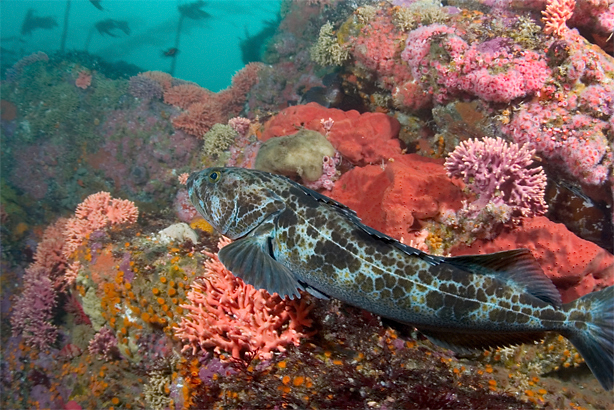
Being ambush predators, lingcod (Ophiodon elongatus) are relatively
tolerant of curious photographers. However, a fish that just sits on the bottom
often makes for a pretty boring picture. Thankfully, lingcod behavior is rather
predictable. With a little luck, one may be able to steer a ling into a desired
posture. This is one of my more successful examples of this. The biggest
challenge with such shots is getting the focus point correct. I have drawers
full of blurry lingcod pictures that I'm not going to show you. Another
difficulty when taking this kind of shot is that you usually only get one
chance. After that, the subject is sufficiently annoyed that you're going to
have a hard time getting close enough.
"East Pinnacles", Carmel Bay, California
January 23, 2005
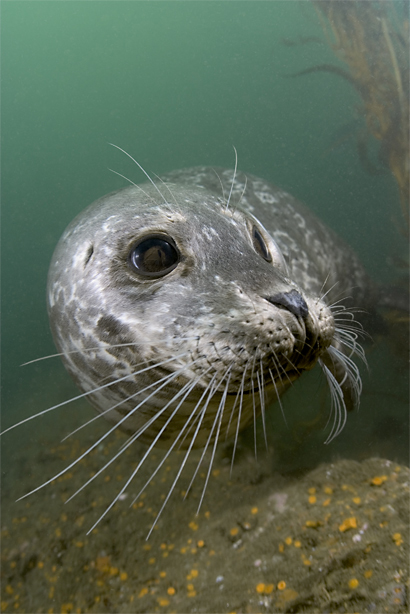
Always wary, harbor seals (Phoca vitulina) spend a great deal of time
scooting along, just a few inches off the bottom. Presumably, this makes it
difficult for predators and prey alike to detect their presence. Since the lens
used in this shot makes the subject appear farther away than it really is, it
may not have occurred to you to wonder why this animal, merely inches from the
camera's dome port is looking at something off to the photographer's right. If I
recall correctly, the animal came this close because it was attracted to the
port itself - they're very shiny underwater. While harbor seals seem to really
like camera ports, they have something of a love/hate relationship with strobes.
On the one hand, strobes such as the YS-90s I was using on this dive are, like
ports, shiny since their outer casings are transparent. On the other hand, they
emit terrible, scary flashes. About five minutes before this shot was taken, an
itchy trigger finger got the best of me and I pressed the shutter while this
seal was still about eighteen inches away. In this position, it was looking
almost directly into the strobes and winced in obvious annoyance. I cursed
myself for being so careless, but the damage was done. In this later shot, the
seal is actually looking at one of the strobes, I suspect with some concern.
Harbor seals are quick to learn how to avoid getting hit with strobes or focus
lights. Once educated, they may still tug on your fins, chew on an offered hand,
and even check out the non-flashy sides of strobes using the universal harbor
seal kiss of investigation (lips parted, mouth closed and pressed against the
object of interest). However, raise your camera, any you'll most likely end up
with nothing but the south end of a north bound seal. Should you find yourself
in such a position, It's time to turn off the camera and just enjoy the moment.
"Tanker Reef", Monterey Bay, California
November 27, 2005
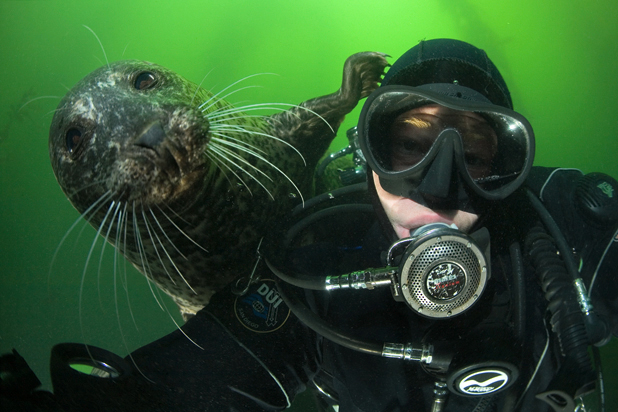
. . . and just when I was all set to take one of my very best self-portraits
ever, someone had to stick his nose in the shot and mess up everything! This
harbor seal (Phoca vitulina) is doing a pretty good job of pushing me
aside. Yes, those are his claws on my head. And yes, they're sharp and can be
felt through a drysuit hood, even the half-inch one I'm wearing. Note the
quarter-inch of water in the bottom of my mask. This is a side-effect of
roughhousing with the fuzzball -- or maybe it's just from an intense fit of the
giggles. This guy is quite the bully, actually. On this dive I'd spent over an
hour playing with a seal that was bit by bit working up enough the courage to do
something more than sneak up from behind to give a little fin tug. A few seconds
before this shot was taken, this original animal was chased off by the snarls of
the animal pictured. Proof, I guess, that competition in nature can be pretty
fierce, even in the pursuit of leisure -- and, I'm pretty sure this is what they
have in mind. Certainly, I'm sure they've figured out by now that my fins aren't
edible. You can't actually see my fins in this shot, you can clearly see some of
the other gear choices I've made (both good and bad). You'll have to indulge me
as I blab about dive gear for a bit. If you don't want to humor me in this
regard, well, then you can just move on to the next caption or something. First
off, photographers (artists that we are) often dress entirely in black. Clearly
that's what I'm doing. Black is pragmatic, (it doesn't show dirt and all), but
is a poor choice if you're going to be someone else's model. Everything black
gets swallowed up into one giant blob. Worse yet, every teeny, eeny, bit of
backscatter looks like a great big honking chunk when it's in front of a black
background. When choosing a color, consider blue, it looks great. My next suit?
Black with white speckles. Why? It's the only color in which the material I
wanted is available. At least, maybe the backscatter will be hidden among all
the speckles. The hood I'm wearing is a custom Otter Bay Wetsuits hood. Pure
genius, these hoods. You have no excuse for not owning one -- well, maybe if you
live in Nebraska you have an excuse, but certainly not if you're a diver, cold
or warm water. The one catch with the Otter hood is that it comes with a giant
Otter Bay logo. I could do without this, I consider it to be in much the same
league as license plate frames emblazoned with a auto dealer's name. I own dry
gloves which are bright blue -- again due to limited availability of colors.
While these have unintentionally made their appearance in far more than one shot
they thankfully can't be seen in a standard self-portrait like this one. This
mask is proof that the best gear is not always the most expensive. In fact,
apart from what you find at the drug store, this Oceanic Mini Shadow is about
the least expensive mask I've seen. If it fits you, buy one. If it doesn't
there's a non-mini version of the same mask so you might try that one. If that
doesn't fit either, then, well, too bad for you. I should admit that while I
don't represent Oceanic in any formal capacity, they have been paying customers
in the past. It's still a good mask, you have my word on it. Of course, I've
made some not-so-good gear choices also. Take the primary regulator I'm using
here (the thing in my mouth). It's plated with 100% pure unobtainium so it was
really spendy. Why? No reason, I just couldn't stand the thought that somewhere,
somehow, there might maybe be someone with more expensive gear than mine. Dive
gear manufactures are fond of such gimmicks. With a little bit of rational
thought (hard for some of us, I know) it shouldn't be too hard to avoid most of
these.
"Tanker Reef", Monterey Bay, California
October 22, 2006
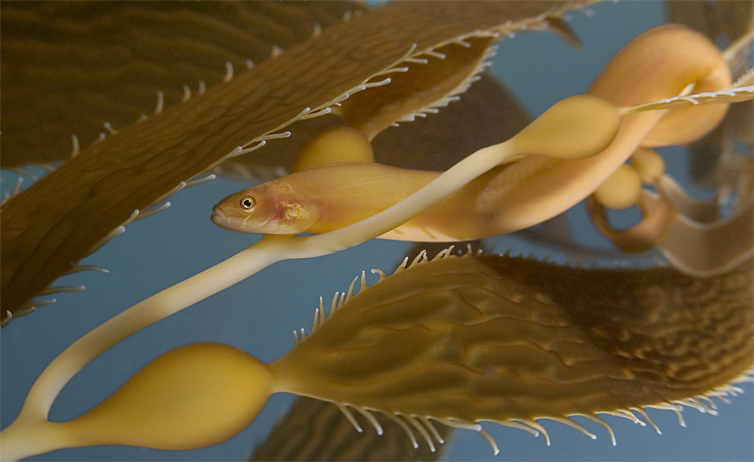
One of the more cryptic denizens of the Monterey bay, kelp gunnels (Ulvicola
sanctaerosae) like this one often display remarkable tail dexterity. If one
is fortunate enough to see this animal at all, it can be quite difficult to
visually trace it from end to end due to it's ability to wrap its tail in
improbably tight coils around stipes of kelp. Small animals that hide in giant
kelp almost universally use the same, very simply, mechanism to deter predators
(and photographers). When discovered, they simply move to the back side of the
stipe on which they're resting. Easy for them, they only have to move a tiny
bit, but a predator/photographer has to move several feet in order to regain
their original view. Of course, what works once, works twice or three times as
well, and you can imagine who usually gets the upper hand in this exchange. I've
tried rolling the kelp's thallus in my fingers to present subjects to the
camera, it doesn't work as well as you might think. The classic solution to this
problem is to place a hand on the backside of the stipe to scare the subject to
the camera side. This works somewhat for wide angle shots if you can get your
scaring hand out of the shot before the subject slips behind the stipe again. It
doesn't work well for macro since it's quite difficult to keep the camera rig
steady with one hand.
"Tanker Reef", Monterey Bay, California
December 4, 2005
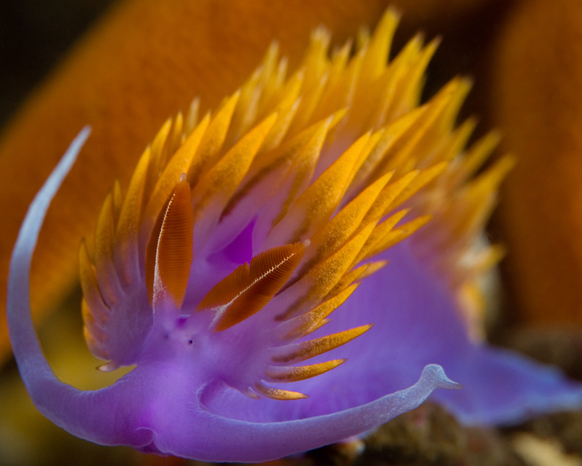
The vibrant colors of a Spanish shawl (Flabellina iodinea) provide
photographers with great raw material. Of course, there's always a catch: These
inch-long slugs flap violently in the surge like one of those cat toys made from
rubber bands on the end of a stick. As such, getting the rhinophores in focus is
often an exercise in frustration. Even a really good macro lens has difficulty
autofocusing on this type of subject. This shot was taken using a fixed focus
and fine movements of the photographer's hand to achieve focus by moving the
entire camera forward and backwards. The blurry orange arms are those of a blood
star (Henricia leviuscula).
"Shale Island", Monterey Bay, California
February 17, 2007
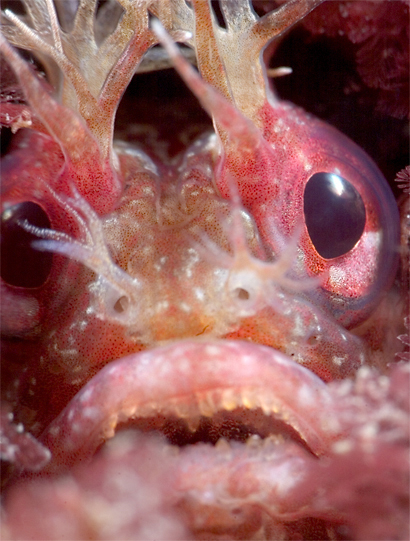
Yellowfin fringeheads (Neoclinus stephensae) have the best coiffure on
the reef. This animal has chosen a conspicuous patch of reef in which to make
his home. As such, it's easy to find. I usually drop by if I'm in the
neighborhood. As with most fringeheads, it's an almost sure bet that it'll be
home. This consistency peaked my curiosity. I wondered if these fringeheads are
exclusively ambush predators or if they sneak out under cover of darkness to
find themselves a meal. Naturally, I paid a visit one day at about one AM. The
hole appeared empty, but to be sure, I illuminated its interior. What I saw was
one perturbed looking eye and a big head of hair withdrawn well into the bore.
Oops! Sorry man.
"Shale Island", Monterey Bay, California
March 19, 2006
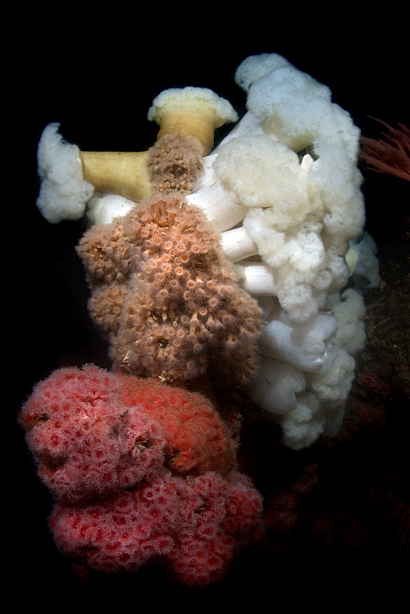
A column of anemones. From top to bottom: giant plumed anemones (Metridium
farcimen), yellow zoanthids (Epizoanthus scotinus), and club-tipped
anemones (Corynactus californica). This is an example of how strobe
lighting can be used to manipulate how the human eye and brain perceive a scene.
In this case the strobes were set to make the Metridiums appear higher
off the bottom than the Corynactus. This isn't actually the case. The
subject's true orientation actually makes it look rather unphotogenic. I was a
little slow to realize how pretty this column is, and, oddly enough, this shot
was taken more out of frustration than anything else. The sole purpose for this
dive was to take pictures of a subject about three feet away. These pictures
didn't turn out nearly as well as I had hoped and I switched to taking shots of
this anemone column to console myself.
"Deep Shale", Monterey Bay, California
April 16, 2005
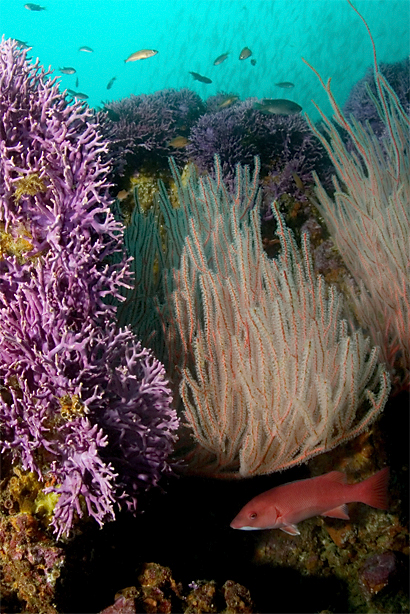
As is typical of wrasses, California sheephead (Semicossyphus pulcher)
begin life as females, but may transform into males in later life. Here, a
demure female seeks the shelter of a red gorgonian (Lophogorgia
chilensis). It's a several hour ride from Los Angeles harbor to Farnsworth
Bank. The long ride, coupled with the time the night before spent in heavy I-5
traffic rather than sleeping, took its toll the day I shot this image. In fact,
I can't ever remember being more miserable out on the water. The day's dives
themselves were clumsily executed, but enjoyable nonetheless. The end of the
second dive coincided with the start of distressingly brisk wind which made the
trek to the night's anchorage a long one. The ascetic accommodations on the
whaler'sanchor locker were never more welcome.
"Farnsworth Bank", Santa Catalina Island, California
April 2, 2005
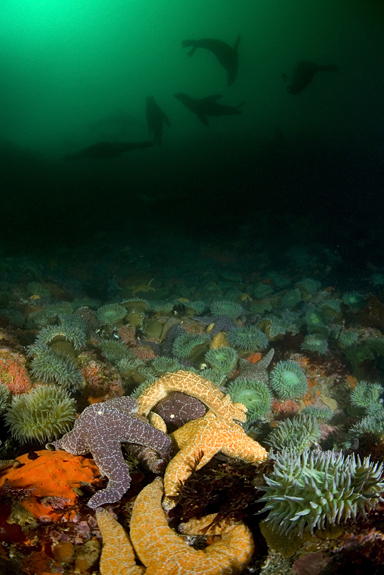
California sea lions (Zalophus californianus) are perfectly at home in
heavy surf. In fact, this rowdy bunch (and, yes, that's a technical term) seems
oblivious to the nearby boiling whitewater (the dark area at top left). Neither
photograpers nor cameras fare as well, but both sometimes venture into such
places in search of good shot. While much of Lobos Rocks is exposed, these ochre
stars (Pisaster ochraceus) and giant green anemones (Anthopleura
xanthogrammica) are found only in a narrow valley on which the ocean's
greatest anger is focused (natch).
"Lobos Rocks", Big Sur, California
August 6, 2006

Green sea turtles (Chelonia mydas) seem to really enjoy taking time out
to get cleaned. These gold-ring surgeonfish (Ctenochaetus strigosus) and
yellow tangs (Zebrasoma flavescens) eek out a living nibling at algae
that grows on the reef. You can imagine their excitment when a turtle who's been
out at sea arrives sporting a shell with a lush carpet of algal growth. This
turtle has an injured flipper. Monofilament fishing line and other refuse create
entanglement hazards for a wide variety of marine animals, turtles included.
"Kona", Hawaii
January 6, 2007
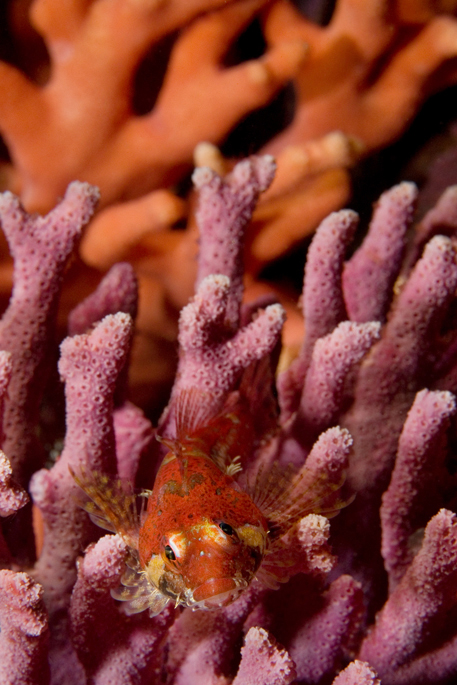
A scalyhead sculpin (Artedius harringtoni) that appears to be fairly
adept at crossing its eyes. This animal's camouflage is defeated by the backdrop
of California hydrocoral (Stylaster californicus). However, there is an
abundance of potential prey hiding within the hydrocoral branches which may make
the risk of venturing out into plain view one worth taking.
"East Pinnacles", Carmel Bay, California
October 8, 2006
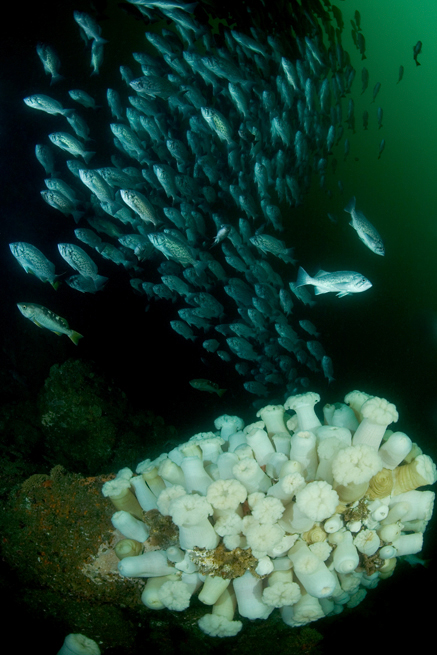
Blue rockfish (Sebastes mystinus) are Monterey's most interesting
schooling fish, particularly when they pack into large, dense aggregations like
this. The corner to corner angle of view in this shot is a full 180 degrees, but
even so, it seems a little too narrow. Super wide angle lenses are, of course,
great for the underwater photographer since they allow pictures of large reef
scenes unobscured by particulate matter in the water. At some point, however,
things start getting difficult. With my current lens, I have to be careful to
keep hands and elbows out of the shot. With a lens that was wider still, I
suspect I might have to -- as a friend of mine has suggested -- tape back my
ears or something. While big schools like this can still be found in more remote
places, it's quite unusual to see something like this in areas that are under
heavy fishing pressure. Actually, in many hundreds of dives in Monterey bay,
this is the only such school I've seen. That this school was considerate enough
to swim next to a big bunch of Metrdidium farcimen was an added bonus.
I'm a extra fond of this picture because it's the only reasonably good shot I've
taken while swimming backwards. "Backwards?" you say. Yes, as it turns out, one
of the charms of the 60's era Scubapro fins I use is that they are particularly
well-suited to swimming backwards. It's something that takes a bit of practice,
but is not so unreasonable as it sounds. And, no, there are no hands involved in
this backward swimming. All this being said, it's most often used to get oneself
out of a tight spot when current or surge is about to smash one into the end of
a narrow hole or crack in the reef. In such situations I'm usually more worried
about scratching my camera port than I am about getting a shot. In this case
however, I was able to correct for an initial overshoot in approaching the
subject. Hopefully this means I've managed to add one more item to my bag of
photographic tricks.
"Ballbuster", Monterey Bay, California
October 15, 2006


















